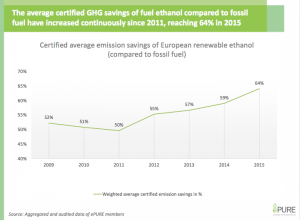 According to new data reported by the European renewable ethanol association (ePURE), ethanol’s direct greenhouse gas emissions (GHG) savings in Europe has increased from 59 percent in 2014 to 64 percent in 2015. The European renewable ethanol industry – Annual statistics report 2016 also found that 99 percent of the agricultural crops and residues used to produce European ethanol in 2015 were grown in Europe. This, says ePURE, has provided growers with a needed source of income at a time when the EU agriculture sector is facing difficult pricing constraints. The study was audited by Swiss company Copartner.
According to new data reported by the European renewable ethanol association (ePURE), ethanol’s direct greenhouse gas emissions (GHG) savings in Europe has increased from 59 percent in 2014 to 64 percent in 2015. The European renewable ethanol industry – Annual statistics report 2016 also found that 99 percent of the agricultural crops and residues used to produce European ethanol in 2015 were grown in Europe. This, says ePURE, has provided growers with a needed source of income at a time when the EU agriculture sector is facing difficult pricing constraints. The study was audited by Swiss company Copartner.
“This audited statistical report reinforces yet again European ethanol’s strong credentials as a low carbon transport fuel,” said Robert Wright, secretary-general of ePURE. “However, despite ethanol’s 64% certified savings and confirmed low land use impacts, our sector faces the bizarre situation that the European Commission seems intent on phasing out readily available conventional ethanol. The Commission instead needs to promote, not hamper, all available low carbon transport solutions, including ethanol, if they are to succeed in their fight to reduce transport emissions.”
The Annual statistic report 2016 also found:
- Since the EU biofuels policy was introduced in 2009, EU ethanol’s average savings increased by 28 percent from 52 percent in 2009 to 64 percent in 2015.
- Ethanol production remained steady in 2015 with 5.8 billion litres produced. Of this, 78 percent of the ethanol was sold in the biofuel market.
- European ethanol producers produced 8.8 million tons of co-products in 2015, of which 84 percent was DDGs.
- In 2015, 37 percent of the ethanol produced was from corn, followed by wheat at 33 percent, sugars at 20 percent with the remaining feedstocks consisting of other cereals and cellulosic material, wastes and residues.

